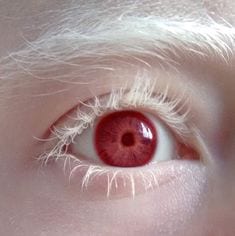Home › Forums › Horse and Musket › Napoleonic › Origins and Facts
- This topic has 79 replies, 16 voices, and was last updated 1 year ago by
 Mike.
Mike.
-
AuthorPosts
-
12/02/2023 at 12:33 #183333
 Not Connard SageParticipant
Not Connard SageParticipantFor what it’s worth, Type 1 OA presents with a cloudy bluish pink iris in mild to moderate cases. More severe cases however
Looks red to me 😉
Obvious contrarian and passive aggressive old prat, who is taken far too seriously by some and not seriously enough by others.
12/02/2023 at 16:46 #183335 OotKustParticipant
OotKustParticipantThanks gents- too me it’s a matter of context, degrees and subtleties… more or less; I’m leaning toward laissez-faire…
if it’s useful information ok, so be it; if theres debate, I’ve done my bit…Edit Added* – Alexandre that Boisellier looks heavily into the Capucine/ Orange environs rather than aurore. First time I think I’ve seen a full size plate- what is its title? I know… Dragon a Pied Tambour… year? Regiment? I don’t have a list either… 😉 *
My sole base of ‘Ingeneurs-Geographic are probably wrong, but I’m going to accept that for the ‘unique’ roles they undertook. And the greatest of them, Bacler d’Albe doesn’t even get the ‘distinctive colour! As part of N.s personal ‘Cabinet’ he will appear tres ‘pres de l’Empereur’.
cheers from Monsoon Valley (Mountain)__
13/02/2023 at 06:49 #183341 OotKustParticipant
OotKustParticipantAnother Post Script- on the matter of ‘fading’ yes I know we are quite accustomed to this in ‘modern’ life.
However, I would say… it’s not always a constant and certainly not guaranteed. Legere ‘blue’ certainly isn’t a faded cloth. We haven’t found it yet, but somewhere there’s a dye mix/ recipe/ ordnance that will recite the practicalities of ‘why’ theirs are habitually lighter than ‘Royal’ or National Blue cloth!Ditto, some colours fade in relation to others; we are reliably informed that ‘indigo’ is one that does not; it wears differently, but if dyed properly cloth doesn’t fade (ie degrade under UV conditions). And two cloths are not the same, so it apears differently.
Scarlet cloth is red because of the beetle used to extract the shade from ground pigment etc…
cheers d
13/02/2023 at 10:03 #183344 General SladeParticipant
General SladeParticipantIs French ‘light infantry blue’ actually a thing? I thought the idea that they wore different colour uniforms to the line just came from the notorious Osprey, ‘Napoleon’s Light Infantry’, which persuaded a generation (me included) to paint their lights in mid-blue uniforms.
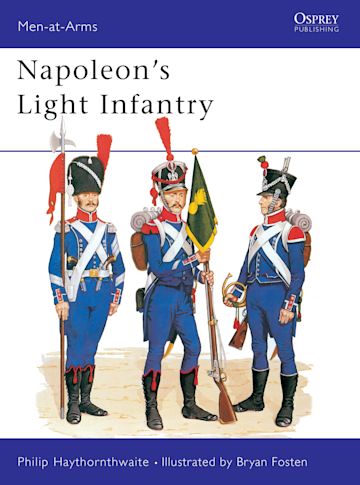 13/02/2023 at 10:30 #183345
13/02/2023 at 10:30 #183345 Not Connard SageParticipant
Not Connard SageParticipantI’m hesitant to argue from a position of authority, and this is second-hand authority from a good source, so do what you will.
Fabric dyes, before the discovery of coaltar derivatives in the mid-19th century were very much subject to fading. Yes, there were mordants that would ‘fix’ them, with varying degrees of ‘permanency’. True permanent natural dyes existed, and those that did – such as purple, vermillion, were expensive. Think emperor’s toga, not a grunt’s tunic.
‘Cloth’ was spun from wool. Wool is tricky to dye, its natural lanolin makes it resistant for a start.
All dyes are subject to UV fading, some more than others.
Add in little or no batch control in all steps of production, and the colour you get ain’t necessarily the colour you got. 🙂
Obvious contrarian and passive aggressive old prat, who is taken far too seriously by some and not seriously enough by others.
13/02/2023 at 11:04 #183346 Not Connard SageParticipant
Not Connard SageParticipantThe problem with naming colours is that the names don’t always mean now quite what they did then.
There’s another colour with an ambiguous name, crepuscule. It exists, it has its own hex color code and everything.
If you had to guess what would you say it was, bearing in mind that aurore and crepuscule are dawn and dusk? 🙂
Obvious contrarian and passive aggressive old prat, who is taken far too seriously by some and not seriously enough by others.
13/02/2023 at 11:18 #183347 Not Connard SageParticipant
Not Connard SageParticipantIs French ‘light infantry blue’ actually a thing?
Nope. 🙂
Obvious contrarian and passive aggressive old prat, who is taken far too seriously by some and not seriously enough by others.
13/02/2023 at 11:24 #183348 General SladeParticipant
General SladeParticipantIs French ‘light infantry blue’ actually a thing?
Nope.
I’m glad about that because I have long since repainted my light infantry in the ‘right’ colour.
13/02/2023 at 20:07 #183359 OotKustParticipant
OotKustParticipantIs French ‘light infantry blue’ actually a thing? I thought the idea that they wore different colour uniforms to the line just came from the notorious Osprey,.

- Yes it is- to me. And justifiably so.
- No, what they did was truly horrendous (amongst others) e.g. Humbol Dragoon Green etc.
However- too much artwork is shown, existing samples of extant cloth AND many many uniform pieces exist that clearly show the difference. As PLD and others have pointed out, unfolding seams of such sewn items ‘discovers’ the true colouration in its original form.
Now I cannot attest to have done so personally, but on the rare ‘up close and personal’ handling of some extant period uniforms, and similar from Second Empire (when technology of clothing had improved immensely) in a non-descript ‘apartement dans les banliues de Paris’ I was given very close, hands on inspection. My greatest regret I did not attempt to take photographic evidence of them (camera was loaded with K64 for exhibition spaces mainly…).
The problem with naming colours is that the names don’t always mean now quite what they did then.
And therein lies TWO issues… our preconceptions of what was meant in an alternate universe; AND the method of Interpretation of same in French, AND the next translation OR TRANSLITERATION applied to Engrish.
One can use the contemporary failed ‘Russian Jaeger Green’ as an example of another botched issue. Recent/ Modern historical researchers have concluded the ‘base’ dark green used was leavened for Jaeger as ‘a lighter green’ shade because [the Russians] did not have a specific word at the time for it. That got mutilated into Engrish as ‘light green’… etc. with consequent ‘interpreted’ results.
Such issues are ‘de rigueur’ for historical analysts… this being an accepted phenomina yet unheard of largely in follow-thy-leader hobbydom.
Pardon my scepticism, it’s how I was made… questioning, reviewing, non-believer until it can’t be undone, …
cheers d
14/02/2023 at 06:27 #183361 OotKustParticipant
OotKustParticipantA “colonel” of a regiment of the guard was typically its operational commander.
A surprising swing back to this subject- a random reading about a certain individual led to another- one Pierre Alexis de Pinteville – Colonel-major des dragons de la Garde impériale
https://fr.wikipedia.org/wiki/Pierre_Alexis_de_Pinteville

His dapper portrait, unknown artist or date, depicts him in 1813 or ’14 however showing the horrendous facial injury. While doesn’t show full generals detail, he does at least bear lace on the collar.
-d
14/02/2023 at 09:42 #183369 HeroyParticipant
HeroyParticipantRussian “green” color names, unlike their “blues” are similar to English ….
Here is how the Russian Establishments of the various dates called out the uniform coats’ colors :
— 23 April 1763 – heavy infantry : green, but not dark as in 1720
— 13 May 1764 – dragoons : blue or cornflower / “синiй или васильковый” / siniy ili vasil’kovyy
— 15 October 1765 – jäger : green
— 16 January 1775 – dragoons : green
— 10 April 1786 – heavy infantry, jäger & dragoons : green
— 29 November 1796 – heavy infantry : of dark-green color / темнозеленаго цвѣта / temnozelenago tsveta
— 29 November 1796 – jäger & dragoons : of light-green color / свѣтлозеленаго цвѣта / cvetlozelenago tsveta
— 30 April 1802 – as per 29 November 1796
— 7 November 1807 – heavy infantry, jäger & dragoons : of dark-green colorofficial clothe swatches from 1799 : in the right-hand column, the 3rd from the top is “dark green”, the 4th is “green” and the 5th is “light green”
https://www.prlib.ru/item/713781#v=d&z=2&n=5&i=11229616_doc1.tiff&y=397&x=337example of both 1796 “light-green” and “dark green” drawn from life 1799
https://uniformenportal.de/_data/i/upload/2014/07/29/20140729210859-8473e340-me.jpgexample of both 1802 “light-green” and “dark green” drawn from life 1805 (note officers’ coats darker than rankers, even with troops identified as guards – the jäger officer’s is about the same shade as the grenadier’s)
https://uniformenportal.de/_data/i/upload/2014/01/08/20140108224846-5a7aa40e-me.jpgexample of both 1802 “light-green” dragoon and “dark green” musketeer drawn from life 1805
https://uniformenportal.de/_data/i/upload/2014/01/08/20140108224848-250d17de-me.jpgexample of 1796 “dark green” as it was conceived ca. 1845
https://upload.wikimedia.org/wikipedia/commons/d/db/07_0922_Vinkhuijzen_Book_illustrations_of_Historical_description_of_the_clothes_and_weapons_of_Russian_troops.jpg14/02/2023 at 10:55 #183373 Not Connard SageParticipant
Not Connard SageParticipantexample of both 1796 “light-green” and “dark green” drawn from life 1799
https://uniformenportal.de/_data/i/upload/2014/01/08/20140108224846-5a7aa40e-me.jpgThat plate could also ‘prove’ that ‘correct’ colour is a chimera.
Every coat is a subtly different shade.
The officer’s coat is not ‘about the same shade’, it has a much greyer cast to it. I admit to knowing little about the Russian army, but there are two grenadiers. Did jaeger regiments have grenadier companies? If not, again one coat is dark green and the other is much lighter. The jaeger on the right has a coat that tends much more to olive than the chaps in bicornes, who I assume are line infantry of the same regiment as the grenadiers?
Much there to confuse the empiricist, but pragmatists will be happy.
Do you have anything to add to your assertion that
For what it’s worth, the eyes of people with ocular albinism are described in period French dictionaries as “brilliant aurore”.
in the light of my posting a picture of a sufferer?
🙂
Obvious contrarian and passive aggressive old prat, who is taken far too seriously by some and not seriously enough by others.
14/02/2023 at 12:33 #183374 HeroyParticipant
HeroyParticipantI put up the info I found on Russian “light-green” coats, for information. I would never presume to interpret or draw conclusions about this information for any one else.
It might assist interpretation to note that subjects in the background are often shown in lighter color than foreground figures in prints of this era.“Did jaeger regiments have grenadier companies?”
Yes, but not during the era of “light green” coats.“Do you have anything to add to your assertion”
Again, I only reported what I found. However, as eye color associated with albinism is quite varying, added a “for what it’s worth”.“to confuse the empiricist, but pragmatists will be happy”
Sorry, that’s above my education level – which never got beyond the basics of operation for marine engines and equipment.14/02/2023 at 12:45 #183375 HeroyParticipant
HeroyParticipantFollowing are the senior officers of the French guard dragoons in the late Empire, with their official postings. In many cases, they acted at a higher level. For the baron de Pinteville : after the death of the duc d’Istria, the comte d’Ornano took over as provisional commander of the guard cavalry, the baron Letort took over command of the dragoons with the baron de Pinteville as their “colonel-major au titre provisoire”. He never served again after his wounding, but was promoted “maréchal de camp au titre honoraire” on 24 January 1815 (confirmed by Napoléon 3 June 1815).
After another series of events, it fell to the baron Hoffmeyer to command the guard dragoons at Waterloo.
Note also the continuity over the 1st restoration.colonel-général commandant la cavalerie de la garde
— maréchal Jean-Baptiste Bessières, le duc d’Istria (posted 20 July 1804 – killed in action 1 May 1813, and the post was not officially refilled)colonel commandant les dragons de la garde
— général de division Raymond Gaspard de Bonardi, le comte de Saint-Suplice (posted 12 July 1809 – recalled to France 11 January 1813 – named governor of the palace at Fountainbleau 2 March 1813)
— général de division Philippe Antoine, le comte d’Ornano (posted 21 January 1813 – held the post through the 1st restoration and the 100 Days – arrested and exiled 24 July 1815)colonel-major commandant en 2e les dragons de la garde
— colonel de cavalerie Louis Michel Letort (posted 1 June 1809 – baron 9 September 1810 – promoted général de brigade 30 January 1813 – promoted général de division & comte 13 February 1814 – held the post through the 1st restoration and the 100 Days – killed in action 15 June 1815)major des dragons de la garde
— colonel de cavalerie Louis Ignace Marthod (posted 5 June 1809 – baron 5 March 1810 – wounded and taken prisoner in Russia, died 5 October 1812)
— colonel de cavalerie Pierre Alexis de Pinteville (posted 3 February 1813 – baron 19 August 1813 – seriously wounded 17 September 1813 – assigned to reserve status 22 April 1814)
— général de brigade Louis Claude, le baron Chouard (posted 6 October 1813, but never took up the post due to ill-health)
— colonel de cavalerie Laurent, le baron Hoffmayer (posted 1 December 1814 – in demi-solde 16 December 1815)14/02/2023 at 17:42 #183394 OotKustParticipant
OotKustParticipantHeroy wrote: example of both 1796 “light-green” and “dark green” drawn from life 1799 https://uniformenportal.de/_data/i/upload/2014/01/08/20140108224846-5a7aa40e-me.jpg That plate could also ‘prove’ that ‘correct’ colour is a chimera. Every coat is a subtly different shade. The officer’s coat is not ‘about the same shade’, it has a much greyer cast to it.
Thanks Alexandre, I never expected to see such identification for Russian colouation.
[PS-Edit- I think if we had this conversation face to face it would be over in 15 minutes…].
I think me old Sage that what you write is just the point, there is interminable variation and the sad state of affairs is that ‘we expect’ a single instance to be true~ not so!
And publishers deliver, a single complete ‘source’ as if modern 100% technologically driven resources were employed in the manufacturing pocesses of 2-300+ years ago. Simply incomprehensible.
No Tsar on earth could direct or control a myriad of sourced materials, dyes or processing. All they could hope for was a ‘movement toward’ uniformity.
A decade spent in manufacturing Quality Assurance taught me a lot. As did having to educate others [in the principles and actions of…], which is bizarre for someone who never went to uni either!
I drew the parallel between the French and the Russians because, greens or blues, the colours don’t mix!
Ever seen a line regiment wearing the ‘legere’ shade of blue depicted. No, I think not! Given the 4x ratio, how could it not have happened? Yes, we have seen newly outfitted legere apparently given ‘national blue’ habits. On occassion, and probably again, a special reason for it. Never specified tho.
Note also, that class of troop called ‘Middle or Young Gard’- never until the very last instances, do they appear in any ‘legere blue’ shades. I rests ma case m’lord!
cheers davew
14/02/2023 at 19:41 #183395 OotKustParticipant
OotKustParticipantofficial clothe swatches from 1799 :
Any idea what the numbers represent?? Cant see a consistency… the text would be ideally a wonderful translation, but old? Cyrillic and no download available anyway… oops I thought it was 5 pp, but actually 288 cited! A list of the regiments by look of the titles and brief paragraphs!
thanks davew
(PS should copy Orspray so they can re-issue with ‘corrections!)… mind again I’m falling for the ‘regulations, or is it merely a record of, existing?
15/02/2023 at 07:43 #183400 HeroyParticipant
HeroyParticipant“what the numbers represent?”
The whole work is a unit chronology for then-existant regiments. The numbers are the numbered entries for the units. Here is the total work:
https://www.prlib.ru/item/713781
The samples pasted into the book are cut from larger samples sent to the regiments and to manufacturers.
The same unit chronical information (and much more) is in the Vikovatov and available in English thanks to Mr. Mark Conrad:
https://marksrussianmilitaryhistory.info/#Viskovatov15/02/2023 at 09:47 #183405 OotKustParticipant
OotKustParticipantMany thanks, that clears up my concerns- I’ve been to Conrad many times but nOt seem the samples before- nor I think spotted the chronology of regiments. But it is complex, so could have missed entirely…
dave
15/02/2023 at 14:43 #183429 Not Connard SageParticipant
Not Connard SageParticipantHeroy wrote: example of both 1796 “light-green” and “dark green” drawn from life 1799 https://uniformenportal.de/_data/i/upload/2014/01/08/20140108224846-5a7aa40e-me.jpg That plate could also ‘prove’ that ‘correct’ colour is a chimera. Every coat is a subtly different shade. The officer’s coat is not ‘about the same shade’, it has a much greyer cast to it.
I think me old Sage that what you write is just the point, there is interminable variation and the sad state of affairs is that ‘we expect’ a single instance to be true~ not so! And publishers deliver, a single complete ‘source’ as if modern 100% technologically driven resources were employed in the manufacturing pocesses of 2-300+ years ago. Simply incomprehensible. No Tsar on earth could direct or control a myriad of sourced materials, dyes or processing. All they could hope for was a ‘movement toward’ uniformity.
Well that is what I’ve been banging on about all along 🙂
As it goes, those colour swatches look considerably faded. The greens appear more like a WWII Soviet uniform.
Obvious contrarian and passive aggressive old prat, who is taken far too seriously by some and not seriously enough by others.
15/02/2023 at 19:57 #183450 OotKustParticipant
OotKustParticipantAs it goes, those colour swatches look considerably faded.
I wouldn’t say that personally. Being photographs of real cloth, too close up detailled probably, and not a ‘uniform size’ look, – not faded but less accurate; it is the contrast between them that is AS important AS the actual shade.
I’d [expect/ like to] think archived material (paper and cloth and uniforms) would have been properly protected; not left languishing on a library table for decades… d
17/02/2023 at 21:25 #183524 OotKustParticipant
OotKustParticipantIn a somewhat shock/ horror tell-all PLD has launched some ‘facts’ on one of the unknown, and largely irrelevant to wargaming ‘units’ of the French.
– –As my focus on history leans on the Army of the Ocean Coasts (not designed by Napoleon btw, or even Buonapart at all- but a Revolutionary era ‘counter-measure’); the so called ‘Camp du Boulogne’ etc. [though there were SIX coastal corps established] to create the force that evolved into La Grande Armée in 1805, so do many of the administrative corps come from there.
We had been led to believe by the French historical press (from Bucquoy etc. onward) that body known as “the Guide Interpreters of the Army of England” were a military unit with intentions, as depicted by its’ title, to act on supposed invasion of England.
However, in a ruse de guerre, it seems the ‘unit’ though public was in fact a covert political force-
From this came the Company of Guide Interpretors … attached to the Cabinet Noir, which had established links with Irish radical groups which were centred in Flushing, Ghent and Hamburg.
This unit of emigre radicals became the cadre of the Guide Interpretors of the Army of England. In concept it brought together ‘the troublesome’ emigre radicals into a single point. It gave Dupont dErval his own private force of insurgents. The defect of this was – as could be expected – the polticial differences between the different radical factions.
So, upshot being, there wasn’t much of a ‘unit’; uniforms cited seem inconsistent and probably hypothetical, and somewhere else he’s cited that they had no horses as no ‘Government’ authority wanted to pay for them before 1806 anyway. Such would be the reasons that they never left Boulogne environs with the army.
No doubt a cross-over with PLDs recent works on revolutionaries and factions inside the UK of the era (the newly integrated ‘Ireland saga etc.), this effectively ends any reason for me to create such exotica with my ‘commands’.
What remains however are the genuine ‘Polish [Liaison] Officers’ later attached to commanders within the Grand Army on its way across Europe.
*Taken from FB posts etc.
cheers d
01/04/2023 at 00:57 #184615 OotKustParticipant
OotKustParticipantAndré Joineau (for web-use – modern) https://i.servimg.com/u/f91/09/01/04/33/nuanci11.jpg .
He says for oil painting, 80% naples yellow, 20% vermillion, and a small “pinch” of white.
Boisellier (20th century) https://www.soldaademohler.fr/wp-content/uploads/2020/06/IMG_3166.jpgWanting to create my own permanent reference material, I decided to ‘adjust’ the Boisellier print as shown, by dialling back the ‘red’ spectrum to something nearer what the Joineau ‘scale’ may look like. Not quite perfect but IMO a better ‘likeness’ that a modeller can live with.
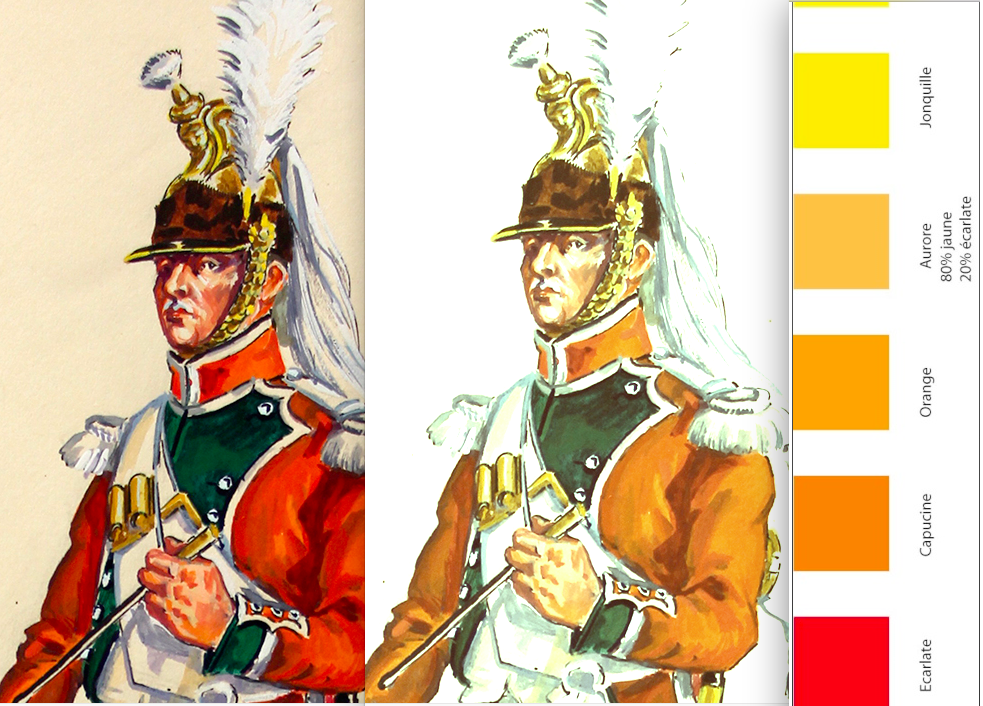
and, both improving I feel and ‘maintaining’ the green revers etc. facings in perspective.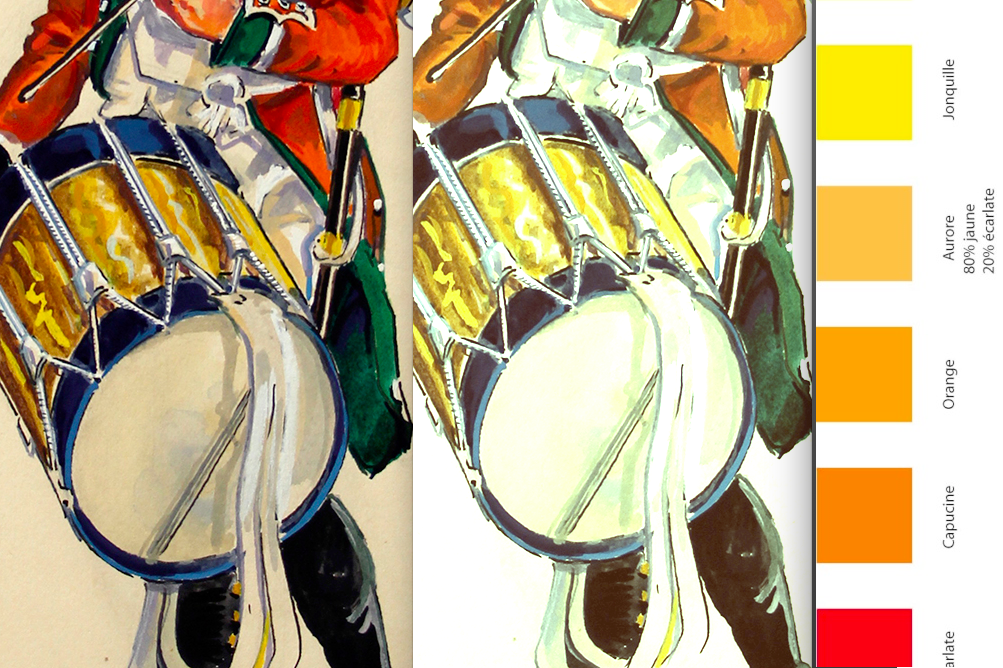
Another that popped up as I finally got to completely thumbing my years reference materials, with this time perhaps some ‘era-fading’ discolouration came on pp 246-7 of “J’étais Soldat de Napoléon!” cited here: https://www.thewargameswebsite.com/forums/search/j%27etais/ .
A ‘dragonne’ of a Marin de la Garde- on issued sabre… documented with a miniature prior to WWII but lost for many years afterwards, uncovered in a collection.
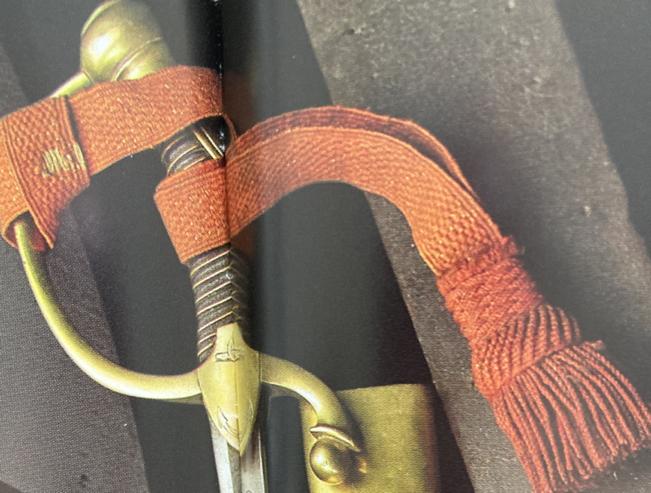
You can make out the fading, but I’ve included the whole thing here to show that such is not even- the damage from some modern chemicals evident (ever spill bleach/ caustic on your best shirt?!) in part on the hilt.
Not trying to prove anything either way, just evidence of what they were perhaps and how the dovish devotion to ‘secondary and tertiary’ sources can be misleading, bending the truth askew…
cheers d
01/04/2023 at 10:11 #184624 HeroyParticipant
HeroyParticipantInteresting.
“‘likeness’ that a modeller can live with” – especially one who paints as badly as I paint.
Thank you very much !
01/04/2023 at 22:32 #184655 OotKustParticipant
OotKustParticipantInteresting. “‘likeness’ that a modeller can live with” – especially one who paints as badly as I paint. Thank you very much !
Oh I’m sure thats not true Alexandre.
Show us some of your work- or all of it! {Yeah that would take me forever also…}cheers d
02/04/2023 at 00:12 #184656 kyoteblueParticipant
kyoteblueParticipantI’m again happy I never got into Napoleonics…
02/04/2023 at 09:19 #184657 Not Connard SageParticipant
Not Connard SageParticipantI’m again happy I never got into Napoleonics…
We’re not all analists mate, but the period certainly seems to attract them 😀
Obvious contrarian and passive aggressive old prat, who is taken far too seriously by some and not seriously enough by others.
02/04/2023 at 09:27 #184658Jim Webster
ParticipantI’m again happy I never got into Napoleonics…
We’re not all analists mate, but the period certainly seems to attract them
I suppose the advantage with ancients is that there are times we have to admit we’re guessing, and with Sci Fi and Fantasy, we’re just making it up as we go along 🙂
https://jimssfnovelsandwargamerules.wordpress.com/
02/04/2023 at 10:33 #184660 OotKustParticipant
OotKustParticipantMy you’re a bitter bunch of a()()()() arent you?
02/04/2023 at 11:15 #184661 Guy FarrishParticipant
Guy FarrishParticipantScarred by the Charleville pattern musket v Brown Bess wars of the 1970s, you should pity them not judge them.
And never rise to any mention of methods of adjusting the position of, moving or resiting unlimbered artillery pieces, it’s a trap!
02/04/2023 at 12:35 #184662 Not Connard SageParticipant
Not Connard SageParticipantScarred by the Charleville pattern musket v Brown Bess wars of the 1970s, you should pity them not judge them. And never rise to any mention of methods of adjusting the position of, moving or resiting unlimbered artillery pieces, it’s a trap!
It’s not a trap, you oaf, it’s a bricole.
Oh. Bugger.
Obvious contrarian and passive aggressive old prat, who is taken far too seriously by some and not seriously enough by others.
03/04/2023 at 15:57 #184683 Sane MaxParticipant
Sane MaxParticipantIt’s OK Connard, it has to be said 3 times for it to work.
Bricole.
03/04/2023 at 19:17 #184695 Guy FarrishParticipant
Guy FarrishParticipantStop that right now!
06/04/2023 at 10:58 #184824 Not Connard SageParticipant
Not Connard SageParticipantMy you’re a bitter bunch of a()()()() arent you?
Not at all. Most of us are pragmatic realists.
Take the dark indigo of French coats. Suppose for a minute that you got your hands on a swatch that had lain in a perfectly climate controlled drawer for the last two centuries, never exposed to light, extreme temperature variations, dust, dirt, or washing. Great, the Holy Grail of uniform colours!
Now you have a perfectly preserved, unarguable, example of French indigo. It appears very dark, but you paint your 28mm French with the colour equivalent acrylic paint that you have very carefully matched exactly to the precious cloth fragment.
Bugger me! They all look like Brunswickers.
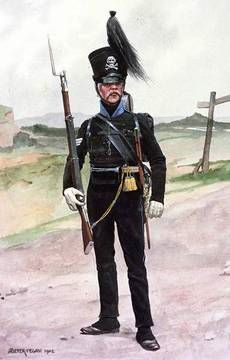
That won’t do, you need something a little more becoming of the effect of the vagaries of scale and light upon your miniature men. So you lighten the paint a little…
Not worth the effort really, was it?
Obvious contrarian and passive aggressive old prat, who is taken far too seriously by some and not seriously enough by others.
06/04/2023 at 18:55 #184856 Guy FarrishParticipant
Guy FarrishParticipantOh I don’t know…
It shows you why various enemies mistook each other for friendly forces and vice versa – Waterloo Prussians perhaps?
And at least you know you’ve painted them incorrectly, albeit for very good reasons, whereas before, in 1972 you (alright, I) accidentally painted the French Imperial Guard Grenadiers in Humbrol gloss enamel midnight blue (didn’t fall for that ‘French Blue’ nonsense!). Well I didn’t know did I? All my metal toy soldiers to that point had been shiny.
I’d like to say after that first contact with other Napoleonic gamers a few weeks later, I rushed home and stripped them and repainted in matt paint. But actually they were still shiny (and as bright as when painted) when I sold them in 2010.
07/04/2023 at 01:15 #184864 HeroyParticipant
HeroyParticipant“a swatch that had lain in a perfectly climate controlled drawer for the last two centuries, never exposed to light, extreme temperature variations, dust, dirt, or washing”
“They all look like Brunswickers”https://www.prlib.ru/item/713781#v=d&z=2&n=5&i=11229616_doc1.tiff&y=397&x=337
Russian dark green – third from the top, right column.
Pantone approximate : No. 4975C “Neutral Black”
RAL approximate : No. 9017 “Traffic Black”07/04/2023 at 02:16 #184865 vtsaogamesParticipant
vtsaogamesParticipantI am happy that my 15mm figures look pretty much like the correct period. That said, I field 1805-9 Austrians at Marengo and such. At least they’re not WWII soldiers. And sue me if the facing colors might not be the exact shade.
In the American Revolution, my British fusiliers wear bearskins. And my SYW grenadiers have colors.
It's never too late to have a happy childhood
07/04/2023 at 13:08 #184886 Not Connard SageParticipant
Not Connard SageParticipantOh I don’t know… It shows you why various enemies mistook each other for friendly forces and vice versa – Waterloo Prussians perhaps? And at least you know you’ve painted them incorrectly, albeit for very good reasons, whereas before, in 1972 you (alright, I) accidentally painted the French Imperial Guard Grenadiers in Humbrol gloss enamel midnight blue (didn’t fall for that ‘French Blue’ nonsense!). Well I didn’t know did I? All my metal toy soldiers to that point had been shiny. I’d like to say after that first contact with other Napoleonic gamers a few weeks later, I rushed home and stripped them and repainted in matt paint. But actually they were still shiny (and as bright as when painted) when I sold them in 2010.
In 1970 I was painting Airfix Highland Infantry in Humbrol gloss enamels. Gloss Post Office Red coats would make the purists shudder.
It was around that time I discovered I didn’t like painting tartans…
Obvious contrarian and passive aggressive old prat, who is taken far too seriously by some and not seriously enough by others.
07/04/2023 at 16:10 #184894 vtsaogamesParticipant
vtsaogamesParticipant…It was around that time I discovered I didn’t like painting tartans…
Need to buy some of that tartan paint.
It's never too late to have a happy childhood
07/04/2023 at 16:28 #184896Jim Webster
Participant…It was around that time I discovered I didn’t like painting tartans…
Need to buy some of that tartan paint.
I was offered some at the very start of the month and like a fool I never bought any 🙁
https://jimssfnovelsandwargamerules.wordpress.com/
07/04/2023 at 21:15 #184897 MikeKeymaster
MikeKeymaster -
AuthorPosts
- You must be logged in to reply to this topic.

